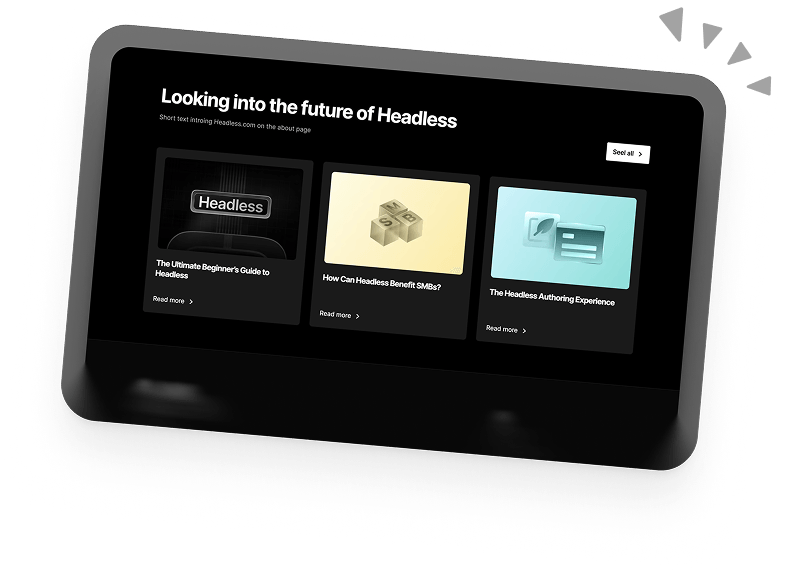What is Component Driven Development? (In a Nutshell)
Component-Driven Development (CDD) is a modern approach to development that makes web applications easier to build, scale, and maintain.
In this post, I’ll explain what Component-Driven Development is, how it works, and how it can enhance your development process.
So, without further ado let’s dive into the world of components!
What are Components?
You can think of components as the building blocks of a web application. They are independent, reusable units of code that embody a functionality or user interface element.
Let’s say you’ve made a button component for your website. You’ve designed it with colours and fonts that match your branding and made an animation for when it’s clicked.
Now you can put that component wherever you want: in contact forms, CTAs, or landing pages. You can even use it outside of the website and put it in a mobile app or email template.
Wherever you put it, that button will look the same and act the same.
What is Component-Driven Development?
Component-Driven Development (CDD) involves designing and building applications from independent components.
Stephen Hay explained the philosophy behind CDD as: “We’re not designing pages. We’re designing systems of components.”
Now, what does that look like in practice?
When building a user interface, you would first design the components, for example:
- Headers & footers
- Buttons
- Drop-down menus
- Contact forms
These will then form your component library. The components serve as building blocks that you then compile into pages. Essentially, it works like Lego. Instead of having to build a model from scratch, you compile it out of pre-defined bricks. But those same bricks can also be used to make something completely different.
Characteristics of Components
- Reusability: Components can be used in different contexts across various sections of an application and even in entirely different applications.
- Scalability: Components make it easier to scale applications. As your application scales, you can quickly expand it by adding new components.
- Independence: Components are only loosely jointed together and don’t rely on other components. This means they are consistent and will look and behave the same across other applications.
- Flexibility: You can configure components to slightly adjust the way they behave. This means you can adapt them to different situations without needing to code them from scratch.
Why Component-Driven Development?
Fast and Efficient Development Process
Component-Driven Development (CDD) effectively decouples the development process. As each component is built independently, teams can work on their separate components without being reliant on others.
And since components can be reused, the whole development process is drastically faster. Instead of building pages individually, you can quickly assemble them from your component library.
Efficient Testing
When the system is divided into separate components, it’s easier to test the functionality of each component. You can ensure that every component functions correctly before integrating it into the larger system. It also allows you to isolate bugs by testing at the component level. It’s faster and takes less effort when debugging code compared to testing pages or full user interfaces.
Easier Maintenance
The modular structure of CDD allows you to replace or update components without affecting the rest of the system. So, when you want to change a specific part of your application, you can easily update that component without modifying other parts of the application. When issues with bugs come up, they can be easily traced back to a specific component which significantly reduces the time spent on debugging and fixing bugs.
Improved Scalability
Each component can be designed to handle increasing loads or replicated to handle more use cases. As your project expands, you can add or reuse new components without interfering with the overall functionality.
Enhanced UX
Building with components means you don’t have to run the risk of inconsistent user experiences. This is especially true with large projects that spread over multiple platforms. By reusing the same components, you can create and maintain a UI/UX that is distinctly yours.
Components and Composability
One principle that makes the concept of “Components” work is Composability. Composability is the trait that allows components to be combined in different ways to build larger software systems. Essentially, composability refers to the ability to assemble and reassemble components to create functional units that fulfil diverse requirements.
What’s intriguing about composability is that it brings several valuable attributes to software applications and components beyond just reusability. For instance, a composable system is typically easier to maintain and scale due to the independent nature of the components.
Composability is also central to composable architecture, where systems are designed to be flexible, interchangeable, and capable of functioning independently while integrating seamlessly within the broader system.
Likewise, in composable commerce, business platforms are designed to be modular and flexible, enabling businesses to tailor their digital commerce experience without the limitations of rigid, traditional systems.
In essence, while component design targets the efficient encapsulation of functionality and data, composability focuses on how these components interact and combine to form more complex systems. Focusing on these two aspects is vital for creating flexible, scalable, and maintainable software. Whether reusability is a primary concern or not, aiming for composability can significantly enhance software quality.
Want to know more about CDD?
Looking for a design and development agency that can optimise your digital products with a component-based approach? Get in touch today and discover how your site or application can benefit from component-driven development!
Bottom line
If your goal is to build software that is scalable, adaptable, and easy to maintain, Component-Driven Development (CDD) is the ideal approach. By embracing modularity and breaking down applications into manageable components, you can establish an efficient, collaborative, and future-proof development process.
Say goodbye to struggling with complex codebases or spending countless hours rewriting code bases. Instead, with CDD, you’ll enjoy quicker iterations, streamlined collaboration, and an overall more efficient development experience.
Book a 30-min Introduction Call
Let's jump on a quick intro call We'll break down your project, and pinpoint exactly how we can help.



Our clients  Holaa! love working with us see their stories below!
Holaa! love working with us see their stories below!






